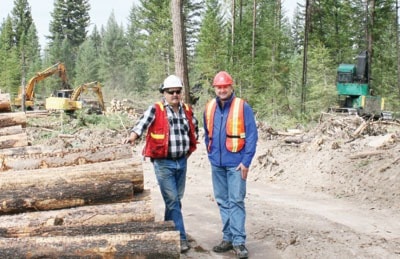The third year of harvesting is now underway at the 100 Mile House Community Forest.
District of 100 Mile House Councillor Bill Hadden says the operation is running smoothly and efficiently, and will continue through the fall.
The benefits are spread around the community in several ways, he explains, by contributing to the local economy, feeding the local mill to help maintain jobs, and projecting a source of funds to the municipality through compensation for the timber value, he notes.
It is a "fair deal" and it is all done in a sustainable manner, he adds.
"In the last year, we've changed our focus a bit, and we went for fuel management-type blocks."
In 50 years, Hadden explains, there will be more harvestable timber available through the healthy new growth in the forest.
The district owns the community forest through its 100 Mile Development Corporation.
The area it covers includes parts of Horse Lake Road near Mahood Lake Road and then, roughly, along Highway 24 through Lone Butte and Highway 97 and east to the Forest Grove and Drewry Lake roads, he says, although not in one continuous block.
Hadden notes much of it is also situated behind housing subdivisions, which has an important, practical aspect.
It's all about fuel management, maintaining fences, and even ensuring workplace safety by removing hazard trees, he explains.
"What we're trying to do is get rid of fuel along the major transportation corridors. Because there's a thousand things that can happen [to start wildfires]; the biggest one is cigarettes, of course."
There are active blocks now, as well as proposed blocks that will be taking out trees along fence lines, he adds.
West Fraser Timber Co. Ltd. senior planning forester Mark Runge says it has a "good partnership" with the municipality.
"[It] involves us doing the up-front costs and development, and all the reforestation, and the municipality gets the benefits, without much risk."
All of the harvested wood goes to the local mills, he adds.
"The whole idea behind it was to provide a secure timber source for the mills that provide the jobs and the economy of the 100 Mile community."
Furthering the local benefits, Runge notes West Fraser hired Canim Lake Band's Teniye Logging Ltd. for the harvesting operations that are underway, and Montane Forest Consultants Ltd. for the consulting work.
"We make sure we deal with any of the issues with the ranchers, and the people with trails and [so on]."
There is a legal requirement to contact Crown tenure-holders, such as for rangeland or government-listed trails, he says, but other users may be found along the way.
"They let us know what particular structures they would like put in place, such as fences or cattle guards."
The operations underway are "clear-cut with reserves," which leave green patches of mature and young fir trees between the logged, bare spaces of primarily beetle-killed pines, Runge notes.
"We're going to start with a new crop of new trees. There isn't enough to do a real select cut; it's dead pines, so that's the prime focus here."
West Fraser continues to cut lumber from the pine beetle wood, while non-saw log fibre is redirected to the local Ainsworth Engineered Canada LP facility, he explains.
"We have a fibre flow agreement with Ainsworth, so probably 15 per cent of this wood from the dead pine will end up at the OSB plant. It's only the small, deformed logs that we send there."
Once the dead pine is harvested, Hadden notes that like all area-based tenure holders, they will recalculate their own, lower annual allowable cut (AAC) according to criteria, before sign-off by the Ministry of Forests.
"You wouldn't go up. But there's growth and yield information, there's standing compositions ... one of the bigger impacts of course is old-growth management areas and mule deer wintering range."
It's current 20,000 cubic metres AAC expires Dec. 31, he explains.
Hadden notes the 100 Mile House Community Forest covers 9,800 hectares timber harvesting land base within a 20,000 ha border.
"This is what community forests are really all about; it's retaining wood, retaining people. Some communities have nothing but a community forest, and that is almost what is keeping those communities alive.
"I'm pretty proud of what we're doing here."
